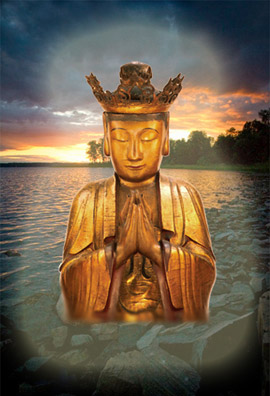 Gautama attained the enlightenment of the Buddha in his final incarnation as Siddhartha Gautama. He was born in northern India, about 563 B.C., the son of King Suddhodana and Queen Mahamaya. Soon after his birth, his mother passed on and he was raised by her sister. At sixteen, Prince Siddhartha married and had a son. The turning point of his life did not occur until the age of twenty-nine, when he set out on four journeys, which presented the four passing sights: (1) a very old man leaning on a staff; (2) a pitiful man racked with disease, lying in the road; (3) a corpse; and (4) a yellow-robed monk with a shaved head and a begging bowl.
Gautama attained the enlightenment of the Buddha in his final incarnation as Siddhartha Gautama. He was born in northern India, about 563 B.C., the son of King Suddhodana and Queen Mahamaya. Soon after his birth, his mother passed on and he was raised by her sister. At sixteen, Prince Siddhartha married and had a son. The turning point of his life did not occur until the age of twenty-nine, when he set out on four journeys, which presented the four passing sights: (1) a very old man leaning on a staff; (2) a pitiful man racked with disease, lying in the road; (3) a corpse; and (4) a yellow-robed monk with a shaved head and a begging bowl.
Moved with the compassion by the first three sights, he realized that life was subject to old age, disease and death. The fourth sight signified to him the possibility of overcoming these conditions and inspired him to leave the world he knew to find a solution for suffering. He left his palace and wandered and meditated for several years and realized the Four Noble Truths, the Eightfold Path and the Middle Way. He passed during the full moon of May, about 483 B.C.
Gautama Buddha today holds the office of Lord of the World. At inner levels, he sustains the threefold flame of life, the divine spark, for all children of God on earth.
Words from the Masters - Gautama Buddha »Adapted from The Masters and Their Retreats
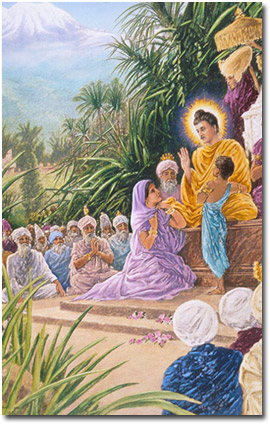 Lord Maitreya holds the office of Cosmic Christ and Planetary Buddha. His name means “loving kindness,” and he focuses the radiance of the Cosmic Christ to the evolutions of earth. Under the office of the Cosmic Christ, Lord Maitreya monitors potential earth changes as well as the comings and goings of the fallen angels and the progress of the Christs incarnate.
Lord Maitreya holds the office of Cosmic Christ and Planetary Buddha. His name means “loving kindness,” and he focuses the radiance of the Cosmic Christ to the evolutions of earth. Under the office of the Cosmic Christ, Lord Maitreya monitors potential earth changes as well as the comings and goings of the fallen angels and the progress of the Christs incarnate.
Lord Maitreya is the teacher of Jesus, who, with Kuthumi, now holds the office of World Teacher. He is known as the Great Initiator and was, in fact, the initiator of Jesus in his individualization of the Christ flame in his final embodiment as world savior and exemplar of the way, the truth and the life to all aspirants on the path of personal Christhood. He was the guru of twin flames in the Garden of Eden, which was a mystery school of the Brotherhood. And Maitreya, referred to as the Lord God in Genesis, was its hierarch.
The long-awaited "Coming Buddha," Maitreya has indeed come to reopen his Mystery School to assist Saint Germain and Portia, twin flames of the seventh ray and hierarchs of Aquarius, to usher in the New Age. As the sponsor of twin flames, he is the friend of all initiates of the sacred fire.
Words from the Masters - Lord Maitreya »Adapted from The Masters and Their Retreats
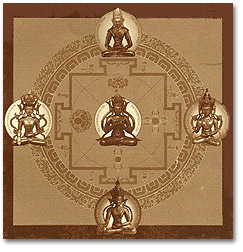 The five Dhyani Buddhas are Vairochana, Akshobhya, Ratnasambhava, Amitabha and Amoghasiddhi. Tibetan Buddhists believe that the Adi-Buddha, the primordial and highest being, created the Dhyani Buddhas by his meditative powers. The Five Dhyani Buddhas are celestial Buddhas visualized during meditation. The word Dhyani is derived from the Sanskrit dhyana, meaning "meditation." They are not historical figures like Gautama Buddha, but transcendent beings who symbolize universal divine principles or forces. They represent various aspects of the enlightened consciousness and are guides to spiritual transformation. Meditative powers are also secret-ray powers, and the Dhyani Buddhas hold the keys to the mastery of the five secret rays.
The five Dhyani Buddhas are Vairochana, Akshobhya, Ratnasambhava, Amitabha and Amoghasiddhi. Tibetan Buddhists believe that the Adi-Buddha, the primordial and highest being, created the Dhyani Buddhas by his meditative powers. The Five Dhyani Buddhas are celestial Buddhas visualized during meditation. The word Dhyani is derived from the Sanskrit dhyana, meaning "meditation." They are not historical figures like Gautama Buddha, but transcendent beings who symbolize universal divine principles or forces. They represent various aspects of the enlightened consciousness and are guides to spiritual transformation. Meditative powers are also secret-ray powers, and the Dhyani Buddhas hold the keys to the mastery of the five secret rays.
Each Dhyani Buddha is associated with certain attributes and symbols. Each one embodies one of the five wisdoms, which antidote the five deadly poisons that are of ultimate danger to man’s spiritual progress and keep him tied to worldly existence. Buddhists teach that the Dhyani Buddhas are able to transmute the five poisons into their transcendent wisdoms.
Words from the Masters - The Five Dhyani Buddhas »Adapted from The Masters and Their Retreats
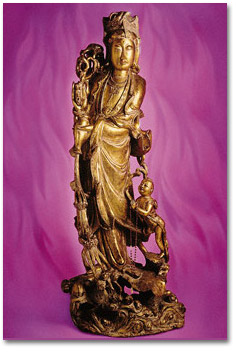 Kuan Yin is revered in Buddhism as the compassionate Saviouress, the Bodhisattva of Mercy. Throughout the Far East, devotees seek her guidance and succor in every area of life. Altars dedicated to Kuan Yin can be found in temples, homes and wayside grottoes. The name Kuan Shih Yin, as she is often called, means “the one who regards, looks on, or hears the sounds of the world.” According to legend, Kuan Yin was about to enter heaven but paused on the threshold as the cries of the world reached her ears.
Kuan Yin is revered in Buddhism as the compassionate Saviouress, the Bodhisattva of Mercy. Throughout the Far East, devotees seek her guidance and succor in every area of life. Altars dedicated to Kuan Yin can be found in temples, homes and wayside grottoes. The name Kuan Shih Yin, as she is often called, means “the one who regards, looks on, or hears the sounds of the world.” According to legend, Kuan Yin was about to enter heaven but paused on the threshold as the cries of the world reached her ears.
The Bodhisattva Kuan Yin is known as the Goddess of Mercy because she ensouls the God-qualities of mercy, compassion and forgiveness. She serves on the Karmic board as the representative of the seventh ray (violet ray). She also held the office of the chohan of the seventh ray for two thousand years until Saint Germain assumed that office in the late 1700s.
Kuan Yin ascended thousands of years ago and has taken the vow of the bodhisattva to serve planet Earth until all her evolutions are free. From her etheric retreat, the Temple of Mercy, over Beijing, China, she ministers to the souls of humanity, teaching them to balance their karma and fulfill their divine plan through loving service to life and application of the violet flame.
Words from the Masters - Kuan Yin »Adapted from The Masters and Their Retreats
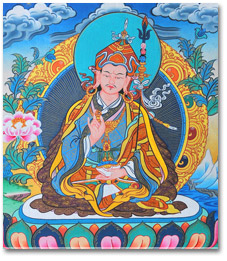 Padma Sambhava is revered throughout the Himalayan countries as the “Precious Guru.” He is the founder of Tibetan Buddhism, and his followers venerate him as the “second Buddha.” Padma Sambhava’s name means “Lotus-Born One.” Although much of his life and work is obscured in legend, he is said to have been the foremost scholar at the famous monastic university in Nalanda, India, in the eighth century A.D. In about 750 A.D., the Tibetan king Trisong Detsen invited Padma Sambhava to come to Tibet. There he helped establish Buddhism by overcoming the forces of the entrenched Bon religion.
Padma Sambhava is revered throughout the Himalayan countries as the “Precious Guru.” He is the founder of Tibetan Buddhism, and his followers venerate him as the “second Buddha.” Padma Sambhava’s name means “Lotus-Born One.” Although much of his life and work is obscured in legend, he is said to have been the foremost scholar at the famous monastic university in Nalanda, India, in the eighth century A.D. In about 750 A.D., the Tibetan king Trisong Detsen invited Padma Sambhava to come to Tibet. There he helped establish Buddhism by overcoming the forces of the entrenched Bon religion.
Padma Sambhava brought an age of great enlightenment to Tibet. Under his direction, an assembly of scholars translated Buddhist scriptures and texts into the Tibetan language, enabling Buddhism to spread throughout the country.
He bestowed upon the messenger Elizabeth Clare Prophet the mantle of guru and gave her the name “Guru Ma.” “Guru Ma” means the teacher who is a devotee of the Divine Mother. Wearing the mantle of guru, the messenger is the servant of the light of God within you. The guru helps you find your way back home to God.
Words from the Masters - Padma Sambhava »Adapted from The Masters and Their Retreats
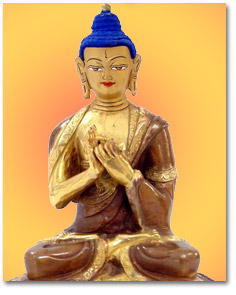 The name Vairochana means “He Who Is Like the Sun” or “the Radiating One.” Vairochana represents either the integration of, or the origin of, the Dhyani Buddhas. His wisdom is the Wisdom of the Dharmadhatu. The Dharamadhatu is the Realm of Truth, in which all things exist as they really are. Vairochana’s wisdom is also referred to as the All-Pervading Wisdom of the Dharmakaya, the body of the Law, or the absolute Buddha nature. It also represents the causal body around the I AM Presence in the Chart of Your Divine Self.
The name Vairochana means “He Who Is Like the Sun” or “the Radiating One.” Vairochana represents either the integration of, or the origin of, the Dhyani Buddhas. His wisdom is the Wisdom of the Dharmadhatu. The Dharamadhatu is the Realm of Truth, in which all things exist as they really are. Vairochana’s wisdom is also referred to as the All-Pervading Wisdom of the Dharmakaya, the body of the Law, or the absolute Buddha nature. It also represents the causal body around the I AM Presence in the Chart of Your Divine Self.
His symbol is the dharmachakra, the wheel of the teaching, or the wheel of the Law. It denotes the teaching of the Buddha. Its eight spokes represent the Noble Eightfold Path, which Gautama revealed in his first sermon after his enlightenment. His mudra is the dharmachakra mudra, the gesture of turning the wheel of the teaching. Because he embodies the wisdom of all Buddhas, Vairochana’s bija is the universal sound Om. His mantra is Om Vairochana Om.
Vairochana has recently become the eighth member of the Karmic Board, a group of spiritual overseers who adjudicate the karma for the evolutions of this system of worlds.
Words from the Masters - Vairochana »Adapted from The Masters and Their Retreats
